Shop Visit - Little Pops NY Pizzeria
I stopped by Little Pops' brand-new Lisle location for a sit down interview with owner Mike Nelson.
Little Pops started out as a tiny, New York-style outpost in Naperville back in 2014, but has since grown into three separate locations in the far west suburbs.
The original shop in Naperville offers carryout and delivery, while their express location in Aurora offers the same, but with a truncated menu. Their newest location, which has been open almost five months now, is a beautiful, spacious trattoria in Lisle that operates with an extended menu overflowing with specialty pizzas, appetizers, salads, pastas, entrees, and homemade desserts.
The pizza business runs deep in owner Mike Nelson’s family’s DNA, so it feels almost predetermined that he’d own a pizzeria one day, even if it took some incredibly unfortunate circumstances (and fortuitous timing) to get him there.
We spent a lot of time talking about that family, what it means to Mike to be able to give back and be a contributor to his community, and so much more. He’s a wealth of knowledge and experience — he started sharing anecdotes before I even got a question out, as you’ll see below — and I greatly appreciate him finding the time to sit down with me.
Mike: I never knew when we got into this 10 years ago how tight the pizza community is. When Tony Gemignani, who’s a 13-time world champion pizza maker, showed up to my little pizzeria in Naperville with eight other world champions, that’s a special moment. And now I’ve got friends all over the country, all over the world, that we can reach out and talk to, or you have a question, or to help somebody. I let people come in my kitchen and test our ovens all the time. “Hey, we’re thinking about switching to EDGE Ovens, can we come by and checks yours out?” Absolutely. Come on by.
CPN: I’ve heard that a lot. People locally getting help from Tony. Or getting help from someone in New York. Or in Vegas.
Mike: John Arena is always helping people out. I was talking to him once about how we had no room left in our little restaurant, and he goes, “Do you have booths? Because there’s plenty of storage under the seats.” And he starts chuckling, and he’s not laughing at me, he’s laughing with me because he’s been there. I cleared off four shelves’ worth of stuff under the booths and created a whole new space for storage.
CPN: I always love hearing about those tricks of the trade that get passed down. So let’s start from the beginning, what do you love about pizza?
Mike: Pizza is universal. It’s a quick bite to eat. If you’re in a hurry, you can take it with you. You can also sit down and relax with it. Most of the time you’re eating it with other people, you’re eating it with friends and family. And I just love the flavors. It’s a blank canvas, so you can do anything you want with pizza. You can put anything on it. Before I knew about the business part of it, I just liked eating pizza.
CPN: Do you remember the first pizza you ever made?
Mike: Besides the ones at home that were disasters? We’d go to Caputo’s, and try to have a pizza night. We’d lay it out on the counter, all the kids had dough, and there’d be flour everywhere. We had no clue. The restaurant in Naperville, when we opened. That was the first time. I didn’t know how to make pizza. My nephew showed me. My pizza maker and I went to my nephew’s place back in New York to train and in order to see all the recipes and what we had to do in order to open our store 10 years ago. So when we got back, we knew how to stretch out the dough, how to make garlic knots, how to make rolls, how to make calzones.
CPN: So you learned that all in New York, and that’s where the recipe is from?
Mike: Right. But we kind of changed the recipes. Some different flavors. Different tomatoes. Things that we liked a little bit more. Like once we used Stanislaus tomatoes, we never looked back.
CPN: It seems like a lot of the time you end up cooking the version of the thing that you want to eat yourself, and then that’s what you share with everybody.
Mike: Exactly.
CPN: What made you want to open a pizzeria?
Mike: I sold my snow company to a guy in Naperville, and it didn’t go so good. We moved out (from New York) to work with him, and eight months after he goes out of business, and we lose everything. So I bounced around the snow industry, and the landscape industry, and the asphalt industry, for five years — until I got laid off again. My mom invited us down to Florida, to Melbourne Beach, for spring break. We drove through the night and met up at Bizzarro’s New York Pizza in Melbourne, and my wife says, “Why can’t we bring this to Naperville?” We don’t have any money. We’ve lost almost everything. But that night I’m screwing around on the computer, and I’m on Craigslist, and I find this little pizzeria that’s available in Naperville. It’s 1200 square feet, and it has three little ovens in it, a fryer, a six burner stove, a mixer, a walk in cooler, everything is there. And they were asking, like, $2500 a month. So my brain goes, if I sold 30 pizzas a day at $20 a pop, then I can make a living. That’s how I formulated it. But I didn’t know how to make pizzas, so that’s when I called my nephew. So I showed him the listing and all the pictures and asked him if he would be willing to help us open, and he said, “Whatever you want!” They’d been open three years, so I asked him how much they made per year — and again, I just want to figure out how to make a living — and he said, “We just grossed $375,000 after three years.” So we came back from Florida and we figured out how to do it. We got a leasing agent on Tuesday, Wednesday we had a letter of intent, and then by next Monday we had the contract signed. We were all in.
CPN: And what year was that?
Mike: April 2014. And then we opened June 16, 2014, and for the first five years it was day in, day out. So that was in June, then in September the Allstate moved out from next door and everybody was like, “Knock a hole in the wall! We want a restaurant!” But we barely knew what we were doing, so take it easy on a restaurnt. We only had three little tables inside, and three little tables on the patio, but then it started getting cold. So I thought, maybe I can make that hole and just put a few more tables in there, paint it up, just make it somewhere else for people to sit. So a year later we opened up the dining room and had 60 seats in there. And we ran that until COVID came, and then we took the dining room out and put an 8x20 walk-in cooler in because business doubled and we needed the space. The we stretched the front counter out and that all became expediting and delivery. And then we opened up our second location in Aurora in August 2020, and that was an express model, so that doesn’t have the full menu. But Naperville does. And we knew we wanted another dining room, so we were on the hunt for another restaurant. And then this one is Lisle came up, and it took us a couple of years to build it out. But we’re here now with 180 seats, and this is our dream restaurant. This is exactly what we wanted. Bringing a little bit of New York to Chicago.
CPN: In regard to your nephew, do you know where the original recipe came from?
Mike: He put it together. Since he was a teenager he was in and out of different pizzerias. He worked for the local pizza guy, Eddie. And Eddie always had like five or six stores going. And when he first told Eddie he wanted to be a pizza guy, Eddie let him take like four trays of dough in the back so he could just stretch them out. And once you touch the dough, if that’s what you want to do, you know it right away. Before we moved out here, he was looking for a place. He was always testing things out though, you know, how he wanted his sauce. The meatball recipe was their great-grandmother’s recipe. His father, my brother-in-law, came into the business with him. So it just evolved. And we used the same recipes in the beginning, but again, it just becomes more of what you like.
CPN: And what part of New York are they in?
Mike: Their shop is in Orange County, New York.
CPN: And that’s called Little Pops as well?
Mike: They are. Little Pops Pizza. And our original location is Little Pops Pizzeria, because the word ‘pizzeria’ was already on the sign and I couldn’t afford to change it to ‘pizza’. And Little Pops come from their grandparents. When my wife and her brother were little, on their mom’s side, their grandfather is a little guy, and their grandmother is little. On the father’s side they were much taller, so that’s how the kids would indentify where they were going; we’re going to little gram’s and little pop’s, or big gram’s and big pop’s. So he wanted to pay homage by calling it Little Pops Pizza. When I first started dating my wife we would go there on Sundays and have a full Italian meal. So a lot of the recipes came from there. And I pulled a lot of recipes from my childhood and growing up in my uncle’s restaurant.
CPN: What’s changed in the pizza business since you opened 10 years ago?
Mike: The cost of everything has skyrocketed. And for us, we offer a lot more gluten-free products, and vegan products. That’s what’s coming down the pike. So we went out and found a great gluten-free crust. We don’t do it in house, because of the work involved. And we have a great vegan chorizo, vegan sausage, and vegan cheese. And we’re still on the hunt for a good pepperoni, we haven’t found one yet. Two or three years ago, my wife and one of our team members went all around the Pizza Expo, trying all the vegan pepperoni. And they ate so much bad stuff.
CPN: That’s a long day of eating vegan pepperoni.
Mike: Yeah it is.


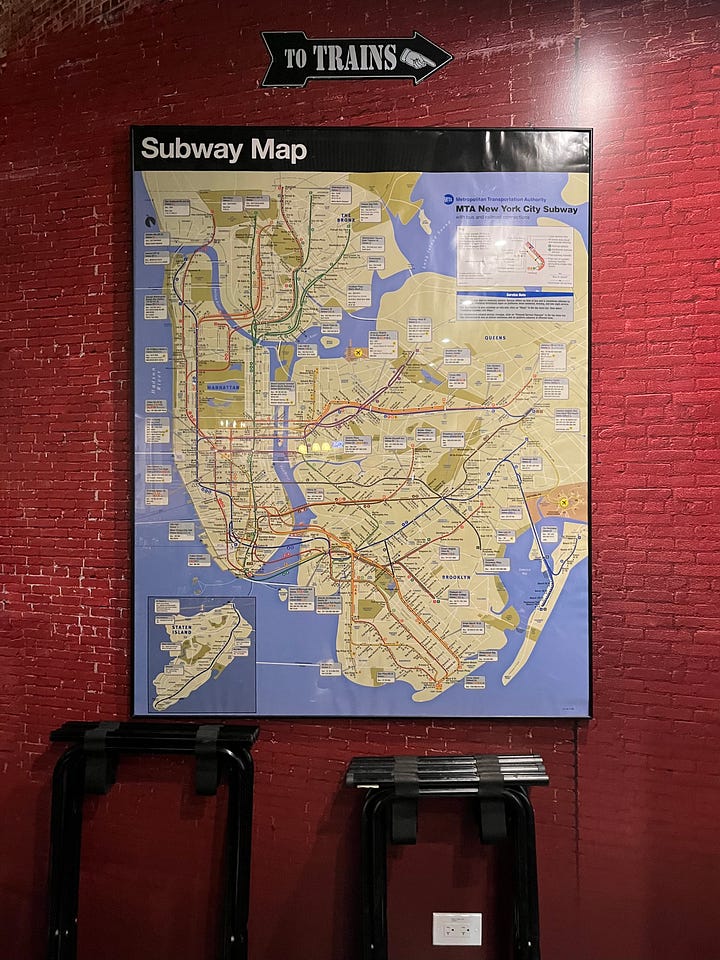

CPN: What’s your favorite pizza besides your own?
Mike: Paulie Gee’s Detroit-style. The Carnivore is amazing. I really enjoy that pizza, and I don’t get it often enough. He really nailed the Detroit.
CPN: How would you describe your pizza to someone who’s never had it before?
Mike: New York-style. And people always ask, “What’s New York-style?” It’s a high gluten dough, hand stretched — doesn’t go through a machine so that the air is still in it. Crispy on the bottom, but foldable, and with a nice chew.
CPN: Were you ever concerned about selling New York-style pizza in Chicago?
Mike: In the beginning, we were. Which is why we didn’t put Little Pops New York Pizzeria on anything, because we figured people might turn their nose up and not even come in. So we just had to get them in the door, and then we could sell them on the slices. In the original location we had, and still have, the slice counter, so you could see the big slices in the window. And we would hook them with the garlic knots. Once we opened though, we had never realized how many East Coasters and transplants were out here looking for this pizza. It blew us away.
CPN: Especially ten years ago. There wasn’t a lot of New York pizza.
Mike: Right. There was nowhere else to go. We would travel to the city to go to Cafe Luigi on Clark. And it was a little hole in the wall that was big as a phonebooth, but they had New York-style pizza and it was really good. And then I found out about Jimmy’s, and a couple other ones, but I never got to those before we opened ours. Have you been to Robert’s at all?
CPN: I love Robert’s.
Mike: I’ve got to get down to the city more, but I just don’t go that direction. It’s hard. And people in the city don’t come out here. Once you’re in your little bubble, I get it. But I do make it to Robert’s once in a while. I was doing something down there and I stopped in to bring two pizzas home. But then I started eating it in the car on the way back, so only one of them made it home. He’s got a really good pie.
CPN: It’s right on the water too.
Mike: It’s a beautiful restaurant. He’s got the perfect spot.
CPN: So what’s special about this area — Naperville and Aurora and Lisle, and how does that fit your restaurants?
Mike: We have the density and the diversity from all the transplants being here. Within a 20 mile range we probably have 600,000 people, whereas my nephew is in a town of 3,000. But he can also deliver three towns over because he can go an entire country mile before he sees a red light. We’ve got a good following, and we’ve got a great loyalty program, and a great Facebook and social media presence — which is all thanks to Stuart, who we work with. He’s done all of our videos, and our food photography. But it’s not just about us, it’s about giving back to the neighborhood, and our impact on the neighborhood. Whether it’s honoring front line heroes, or our fundraising campaigns that we do to give back to the schools. Or when the tornado hit three blocks from our Naperville location, it was important that we’re the first ones out with warm food, going door to door and giving out pizza. I don’t even know how many pizzas we gave out. We raised over $50,000 and gave out gift cards for two years, just to make sure people had a little normalcy in their lives, because that was a terrible thing that happened. It being right in your neighborhood, you’ve got to take a deep breath, then roll up your shirt sleeves and go to work. But that’s what we do. We take care of the neighborhood.
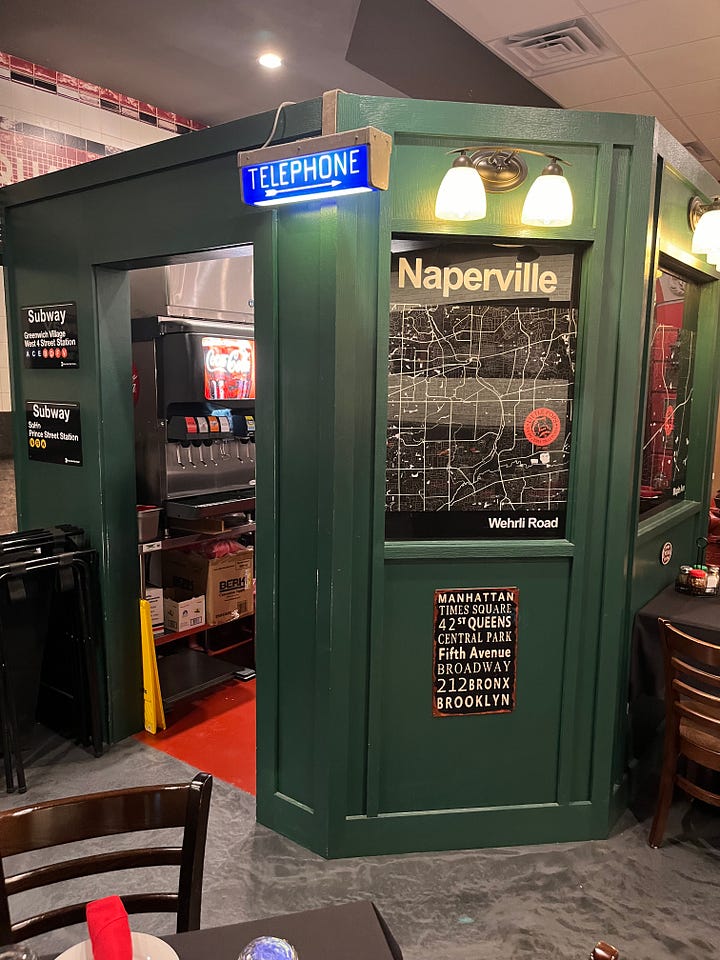
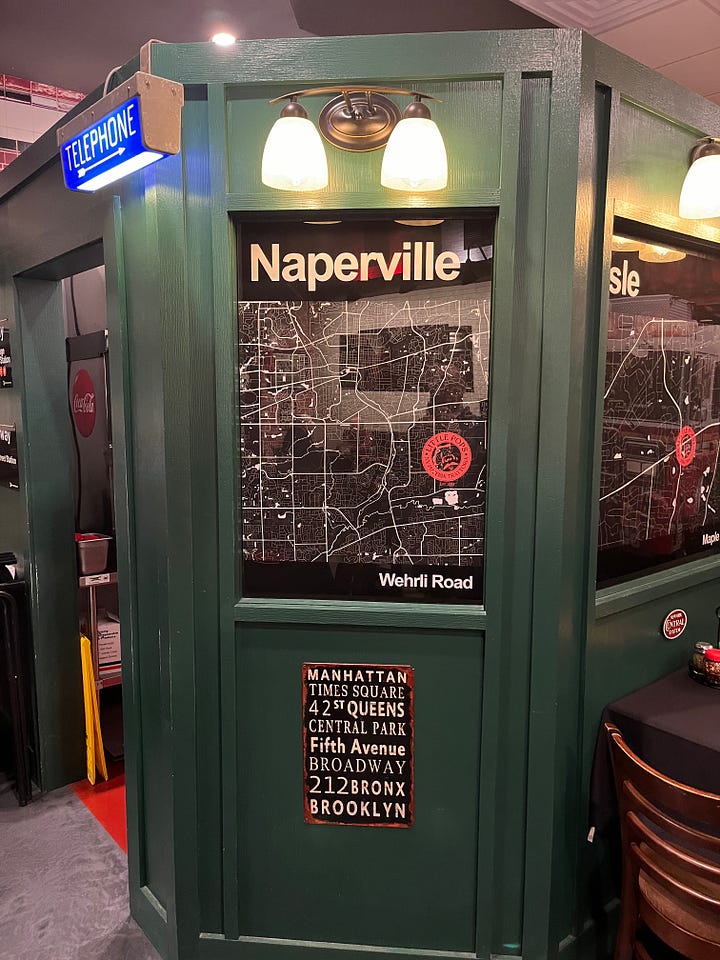
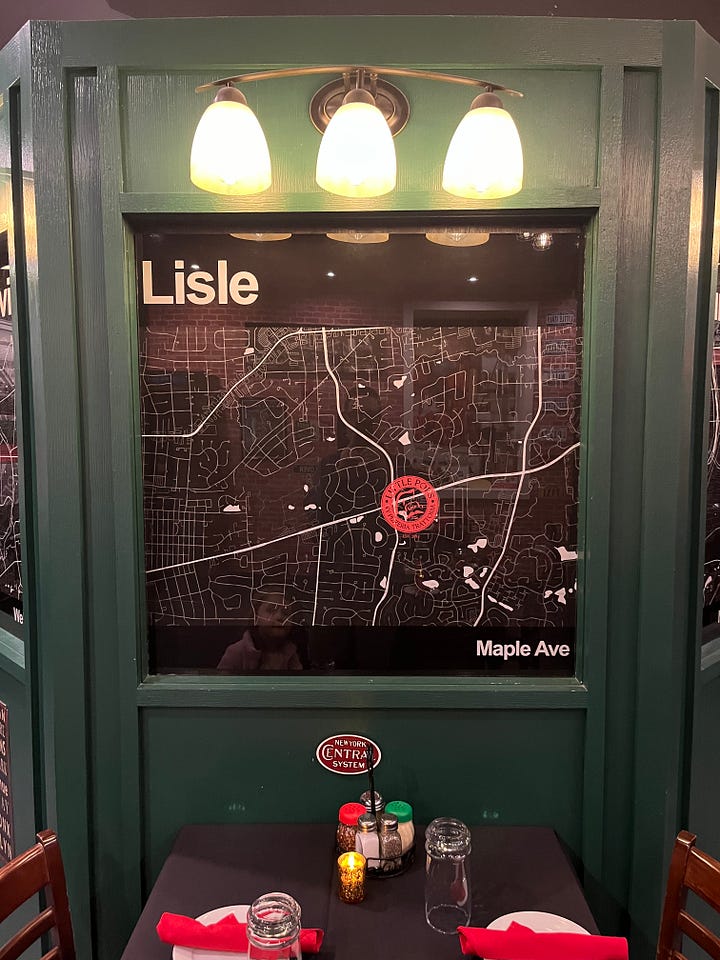
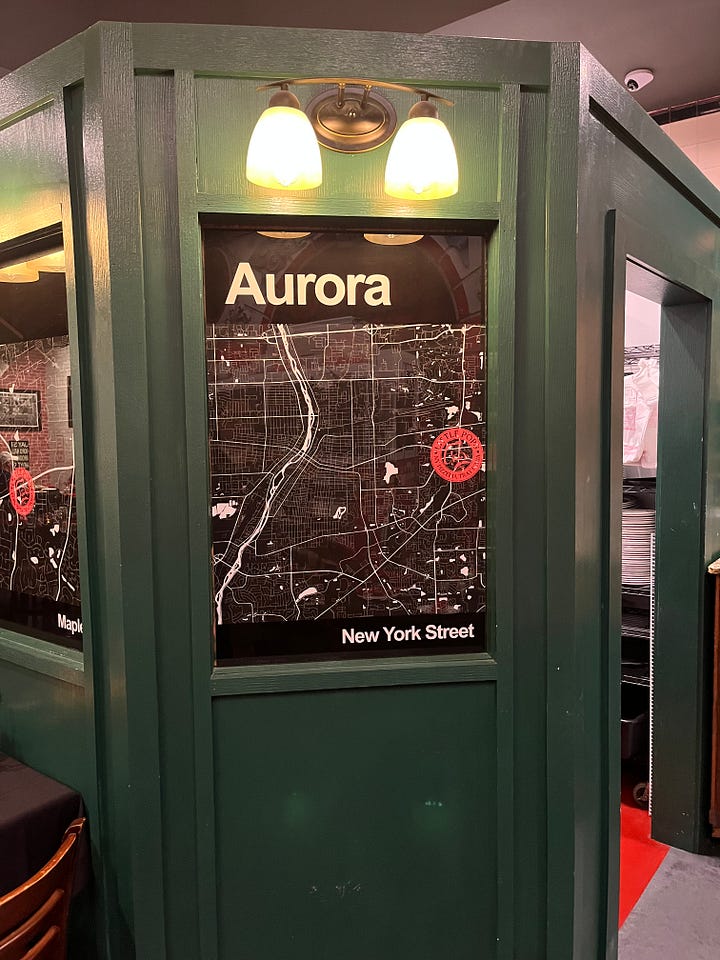
CPN: What does that mean to your family to be a famiy business that’s part of the community in that way?
Mike: It means everything. We don’t have family out here, so our customers and our community is our family. I go to the local Jewel here on Naper Boulevard and the two Nancys, they’ve been there forever, they’re like family. I walk through the store and people are like, “Little Pops! Best pizza in town!” And that’s the relationship we have. It reminds me of when you first get your driver’s license, and you’re driving around and you can’t wait to see somebody you know so you can honk the horn. And I still remember when I was 16 and waving at my aunt coming down the street. It’s great to see your customers in a store, or they pull up next to you and start beeping their horn. And those are the things that keep you going every day. I walk the floor and talk to the customers. “How’s it going? How’s it tasting? How are you doing?”. Or I introduce myself if they’re new, “I’m Mike, and I’m the owner.” But it had been four years since I’ve done that. So to get those people back, and see faces again, and give hugs and catch up. Kids have graduted. Kids have been born. Families have changed.
CPN: And I wanted to touch on that because you had a really cool post on your Instagram about a boy named Jake who first started coming in when he was 13, and now he came to your restaurant for his 23rd birthday. To be that place for someone, that has to be such a great feeling.
Mike: It is. We wants this restaurant to be theirs. To be yours. We want the community to feel like this is a piece of the village. Friday nights are really special, because now pizza nights are back. Families can come in here and feel comfortable. They can have parties. Kids love it, they love the phonebooth, and the pictures on the wall. It’s a family place. And if you want to have an adult conversation, you can go hang out in the bar. And if some families want to sit there, then that’s okay too. I think there’s a little bit of something for everybody here. We have a party room back there. We’re going to open up outdoor seating for about 75 people. It’s exciting.
CPN: How does it feel when somebody tells you that you make their favorite pizza?
Mike: It’s humbling. When we won our first competition, it was a donation for the Lions Club back in 2020 at Naperville Pizza Wars. They asked if we would like to partake, and they were going to have like 8-10 pizzerias, and it’s all for fun and for the Lions Club. And they said just bring a bunch of pizzas and feed people. But they blew the doors off the Naperville Central auditorium. Over 1200 people showed up. We brought 80 large pizzas, then brought in another 80 so we wouldn’t run out. Other pizzerias ran out, but we knew we couldn’t run out. We had like five or six different slices, and we just kept giving them out. We ended up winning. We figured maybe we might get something because there was ‘best cheese’, ‘best sauce’, and ‘best overall’, but we wound up taking all three categories. That blew up our business, and it was right before COVID. We already knew we were outgrowing our little space and were thinking about expanding, but then the world went upside down. We come in every day and we want to make the best product we can. This is what we were raised on, and we’re just trying to share it with the world. So it’s pretty cool when people say, “Hey, you’ve got the best pizza in town.”
CPN: Walking into the restaurant I noticed a bunch of bricks out front with messages engraved on them, what’s the story behind those?
Mike: It took two years to build this restaurant. We originally thought we were going to do it for $650,000, but the deeper we got into the building as we were gutting it, that quickly changed. There was no insulation on the outer walls, so I now I had to stud 220 feet of wall and reinsulate from top to bottom. That was not in the budget. We moved the bar up front, went to hook up the sewer, and you could put your finger right through the cast iron pipe. So we had to dig up all the sewer, and all the kitchen. It seemed like everything we started touching. Then the kitchen had to be gutted, because it was all rotted out. Prices quickly increased. Delays occurred. Rent had to be paid. Electric bill and gas bill is still there. We were running into money problems, and we had our little pizza wagon out front here on Wednesdays to raise funds and to pay the rent and pay the electric. Then customers started to say, “How can we help you?” And we said, we’re okay. But they still wanted to help. So they started a GoFundMe, but it’s funky the way GoFundMe is set up, so they came to us with a couple ideas and suggested a buy a brick campaign. And then we also have a big pizza paddle to the left of the bakery that has a bunch of names on it. And people were also just making donations out of the blue. Somebody came up and just handed us a check for $5,000. Another check came in the mail for $5,000, and now we’ve got tears coming out of our eyes. But it got us from A to B. We’re the ones that normally give back to the community, so it’s humbling to take money from the customers. But they wanted to support us. And that’s where the bricks come from, and all the names on the paddle. Those were the first ones that jumped right out and did what they had to do to help us.
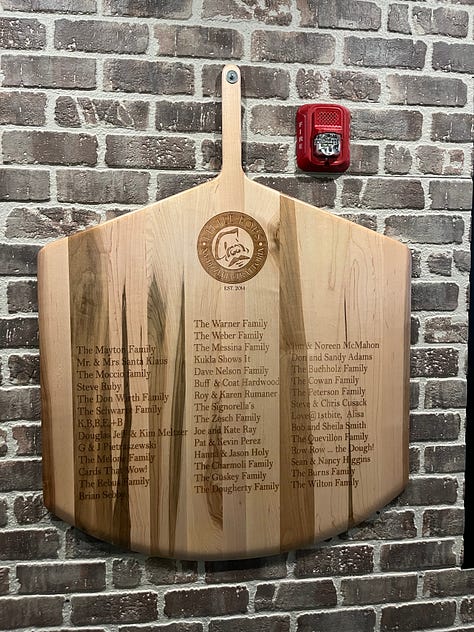
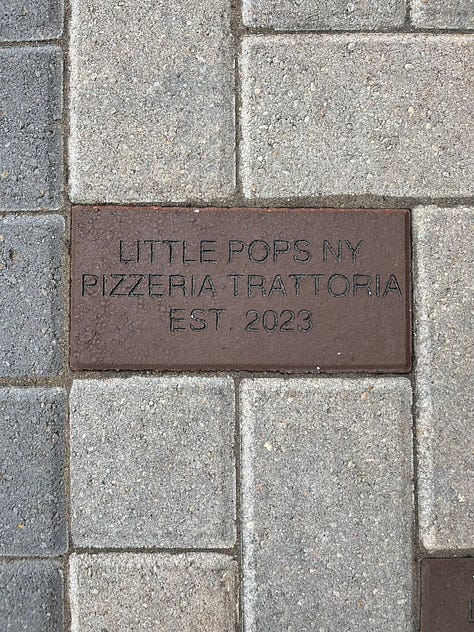
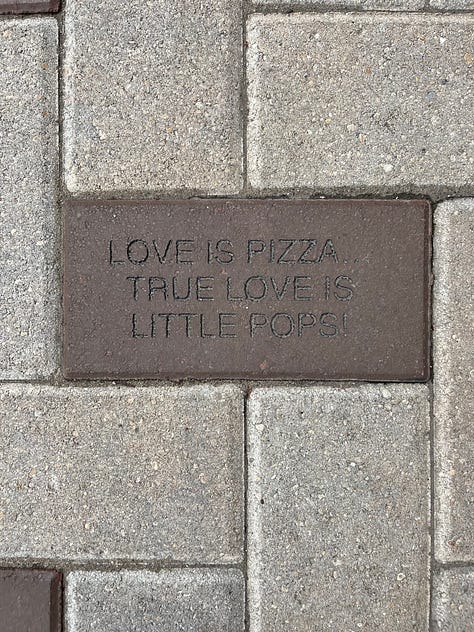
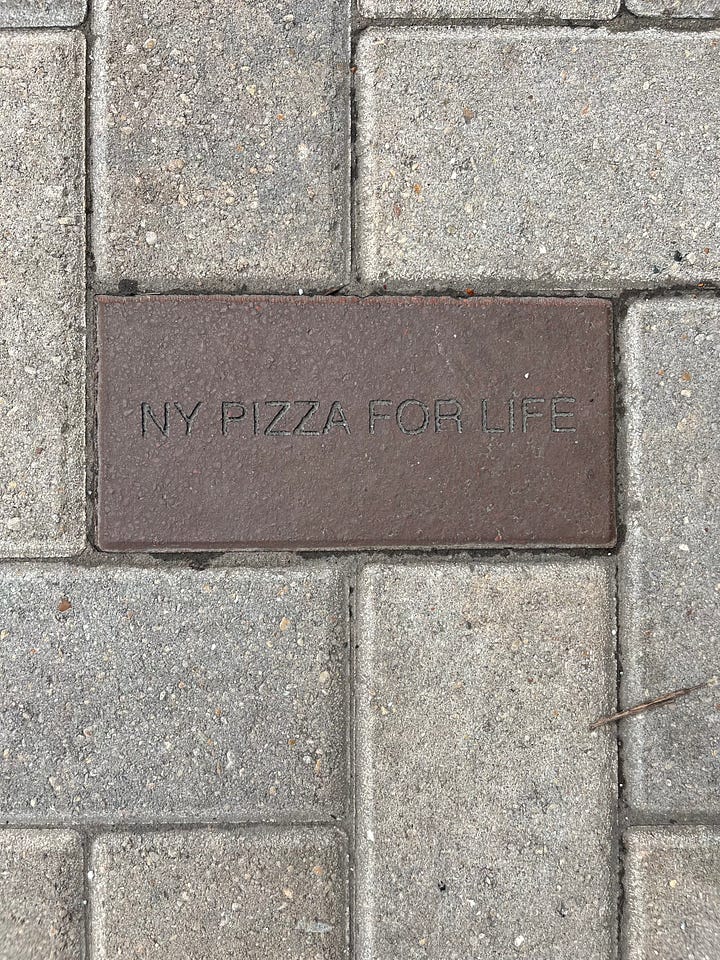
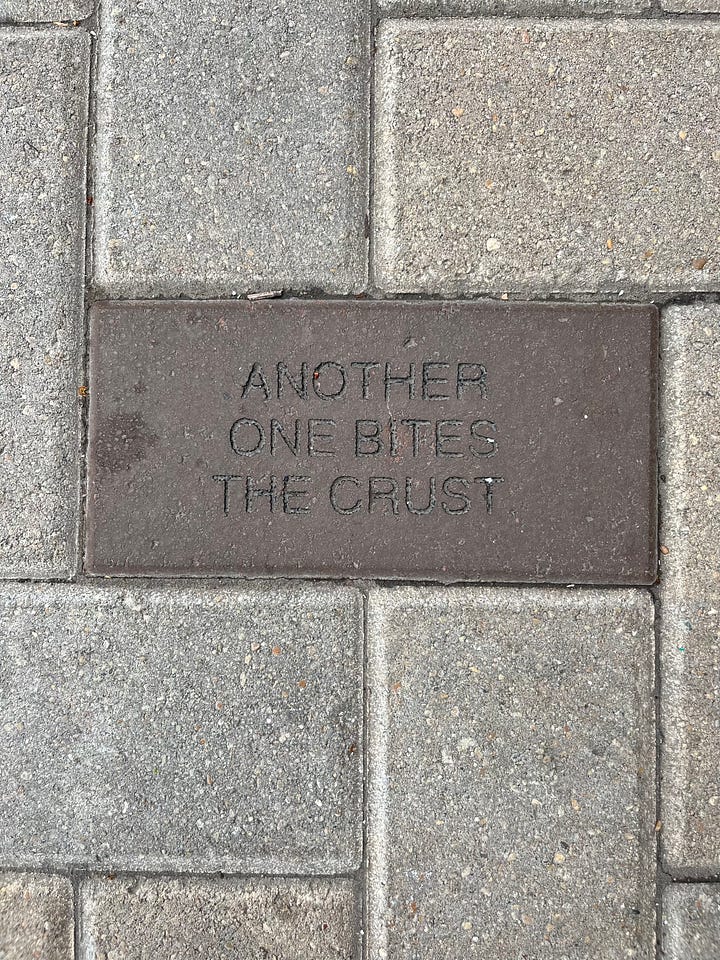
CPN: Do you have plans for more restaurants?
Mike: So all three restaurants are different. Vicki and I own the other two. This one, my son is involved. And we have investors as well that helped us over the finish line. And they would like to continue to grow and do different things. So we’re trying to figure out what that concept would be. Are we gonna do more express locations? Are we gonna do carryout and delivery locations? Or, are we gonna build a smaller footprint of this restaurant with an express menu and maybe a little bar, so people can still dine in? And I think people still really do want to go out. So we’re gonna take some numbers and put it all up on the wall and see what’s sticking. We do carryout here, but we don’t do delivery because our kitchens not set up for it. Our Naperville location does delivery, carryout, and catering. And we’ve been doing that for years. And our express model has an express menu and just does carryout and delivery. It’s surprising how many people come here just to carryout. It blows me away. And Wehrli, our Naperville location, is 70% carryout and 30% delivery. People love to come in and pick it up. What do they get out of it? I don’t know. So if we ever do more here and build it out I’ll have to put in a proper carryout counter. And then maybe I could have a slice shop for lunch again, too. But we definitely want to continue growing. We’ve got a good brand, and good food. We’ve got a great track record, and ten years under our belt already. In ten years I’ve opened three locations, and we’re blessed. Far cry from selling 30 pizzas a day at $20 a pop, right? Not to mention starting when you’re 47 and jumping into this crazy business and working 90 hours a week.
CPN: Do you think that worked to your advantage, though? Not necessarily knowing what you were getting into.
Mike: Yes. And also bringing 25 years of business experience along. My previous life of being in snow removal, or working in construction, and putting 300 or 400 guys on the street every time it snowed. There was a lot of experience coming in as a business owner. The biggest thing is just doing the work. We can all cook and follow recipes. Anybody can do that. But you’ve got to develop a pallet. And you can’t be, “my way or the highway”, you know. I’m only one person. I want to make sure everybody agrees with the flavor. It’s a great business. And I love the kitchen. I designed that kitchen for me, so it’s exactly how I wanted it. And there’s actually two kitchens. A prep kitchen, and the pizza line is set up dynamically so we can do about 225 pizzas an hour and pump out dishes. And then I can still go in the back of that kitchen if I want to play around or to do some catering. So we can do a lot without messing with the flow of the main cook line. And I think back to the Friday nights in our first location with my little six burner when we were first getting started, and you had to be real creative when the dining room is full. But you learn from that. So now we’ve got 22 burners back there total, and five ovens.
CPN: Did you know that The Washington Post was gonna give you the title of best New York pizza in Illinois?
Mike: No idea. We didn’t even know until a customer told us. And that’s how we find out about a lot of things. The customers will find them. “Congratulations! I was just reading The Washington Post and I saw your name in there!” Or, “Hey! I just saw this Yelp list and you got No. 40 on the top 100 pizzas in the United States!” And then we’re looking it up, trying to figure it out. But it’s always exciting.
CPN: When someone comes to Little Pops for the first time, what should they order?
Mike: Definitely try the pizza. And if it’s a group, I’ll tell them not to get mad at me if they eat our pizza for six months before they realize that our entrees are amazing. So this is what I’ll suggest, if there’s four of you, get the stuffed Gnocchi in vodka sauce as an appetizer, then get your pizza, and you’ll thank me later. The secret weapon on our menu is the Gnocchi, which is stuffed with seasoned Ricotta. And that’s the number one seller of the entrees we have. It’s like little pillows from heaven. Then when they ask me what kind of pizza I’m like, okay, the Margherita Pomodoro. Pomodoro is an old school Margherita, with just blots of tomato sauce. And every time they’re like, “Oh my gosh, that’s the perfect combination.” So I steer them down that way. But if they ask me what’s my favorite? I’m a cheese guy. Once in a while I’ll put mushrooms, or pepperoni or whatever, sausage, or green pepper, but I’m a purist. So I stick mainly with cheese.
CPN: I’m kind of the same way. I feel like that’s the best way to taste the actual pizza.
Mike: You’re right. And I always say, to test a pizza — it might taste good right now, but test it tomorrow morning. If you can still get the same flavor, that zing in your mouth, when it’s cold, then that’s really good pizza. Because not every pizza can do that.
CPN: Have you heard of Bob’s Pizza?
Mike: No.
CPN: There’s a couple of them in the city, and their crust is even better the next day. And I have no idea how they do it. It’s almost like a completely different pizza.
Mike: I’m all for it. I love leftover pizza. And that’s what I say about New York-style, you can eat it so many different ways. A slice reheat, you get a different crisp on the bottom. Fresh, right at the table. Or if you’ve brought it home, it’s a little different then when it’s just come out of the oven. The next day, and whether you eat it cold or warm it up. I love this style of pizza. It just works.
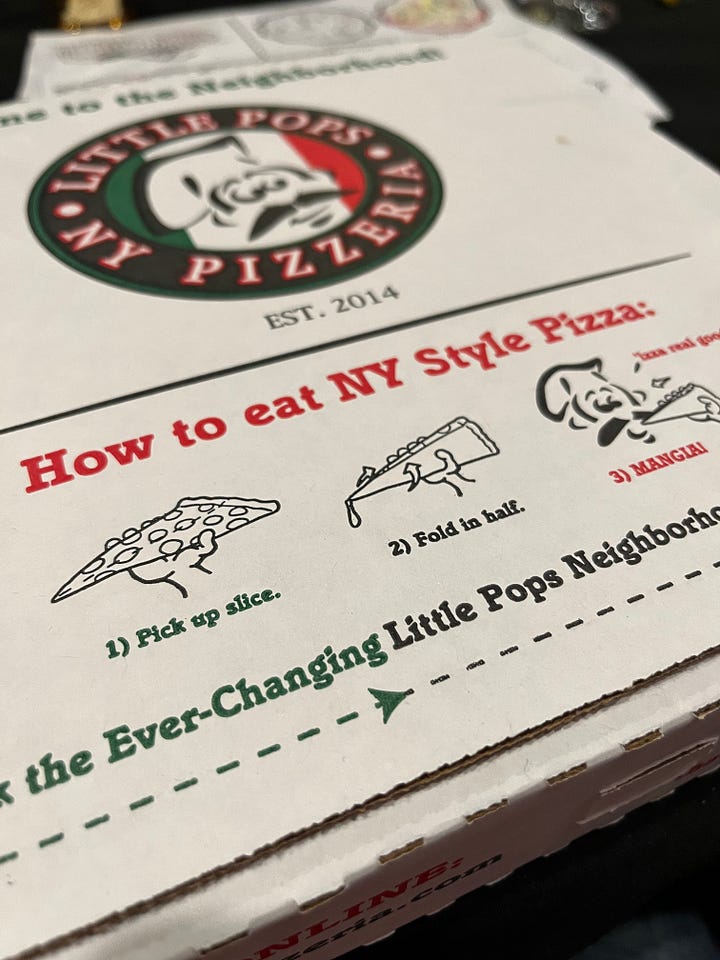
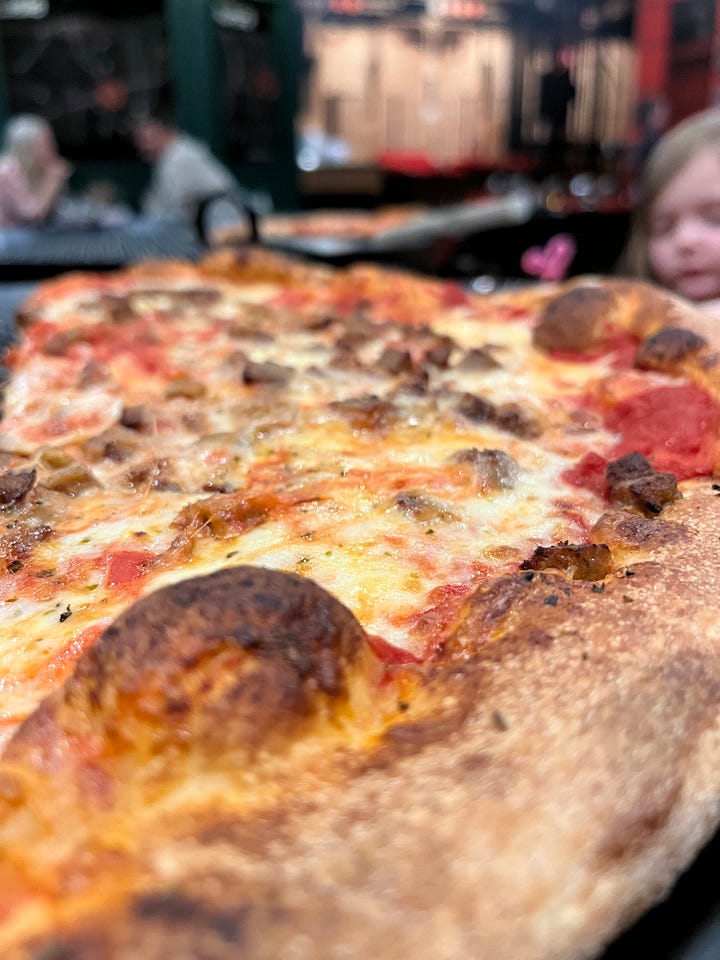
CPN: Did you grow up on slices or were you eating whole pies?
Mike: People ask about my favorite pizza place in New York. First of all, I was upstate, and pizza was on every block. Every town had three or four pizzerias. And every one of them did it a little different. My first pizza was probably John’s Pizzeria, on Main street in Beacon, New York. We’d pull up, and my mom would let me run in, she’d give me the money — two bucks or whatever it was. I’d get a slice, a big, floppy slice on a paper plate, and I’d get back in the car and we’d drive off. Sometimes I’d go for lunch and get a couple slices. Or your parents order the pizza on Friday night and you go get the pie and bring it home. It’s so universal. I don’t remember going to restaurants to eat pizza. It was mostly takeout. Once in a while there might be a couple places with tables, but mostly we’d take it home.
CPN: I have friends from New York, and some of them don’t even like to order whole pizzas, because they’re so used to slices. That’s how they grew up, and that’s their preferred way to eat it. They want it reheated. They don’t want fresh pizza.
Mike: That crisp on the bottom in a whole different animal. And it’s not like you can take Chicago pizza and just reheat the squares. It’s not the same.
CPN: Is there anything else you want people to know about Little Pops?
Mike: Come on in, have a taste of New York, and meet the owner. My wife does all the desserts, and they’re all homemade. She makes cheesecakes, and a seven layer mousse cake, and carrot cake, and tiramisu, and creme brulee. We’re foodies at heart. And we try to bring the best of everything we can to the restaurant to give back to the customers. We love having teams come in. And the police department, the fire department, all kinds of organizations. We love being a part of the community.
Mike and I continued our conversation for quite a while after I stopped recording and he told me something incredibly interesting that I’d never heard, or even really considered before, in regard to the pizza business.
We were talking about the cost of things like serving trays, boxes, and individual ingredients, and he was saying how important it is to him to get the best versions of everything, even if the customers don’t necessarily understand just how much that affects the overall price.
Little Pops uses Grande mozzarella, which is produced in Wisconsin and is the gold standard in the pizza industry, but the price of Grande fluctuates wildly depending on the season. It comes way down in the spring/summer, then shoots up drastically in the fall, all because of the demand put on the national milk supply to provide milk for kids to drink as they return to school every year.
And because we talked about it at length, I had to save a slice to try (cold) the next day.
Little Pops makes some of the best pizza I’ve had so far this year, and I would absolutely put it in the same echelon as Jimmy’s and Professor Pizza as far as my favorite New York-style in all of the Chicagoland area.
So next time you’re out in the suburbs hitting up The Morton Arboretum (or if you have kids maybe the DuPage Children’s Museum or Scene 75), you should swing by Little Pops and say hi to Mike on the way back.
And if you wind up ordering too much, don’t sweat it. It’s fantastic the next day.


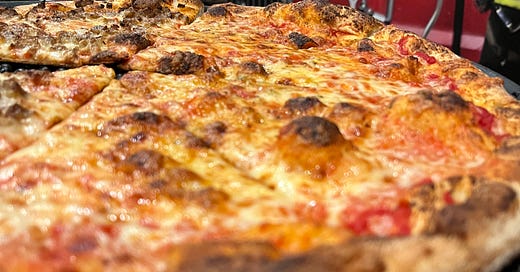






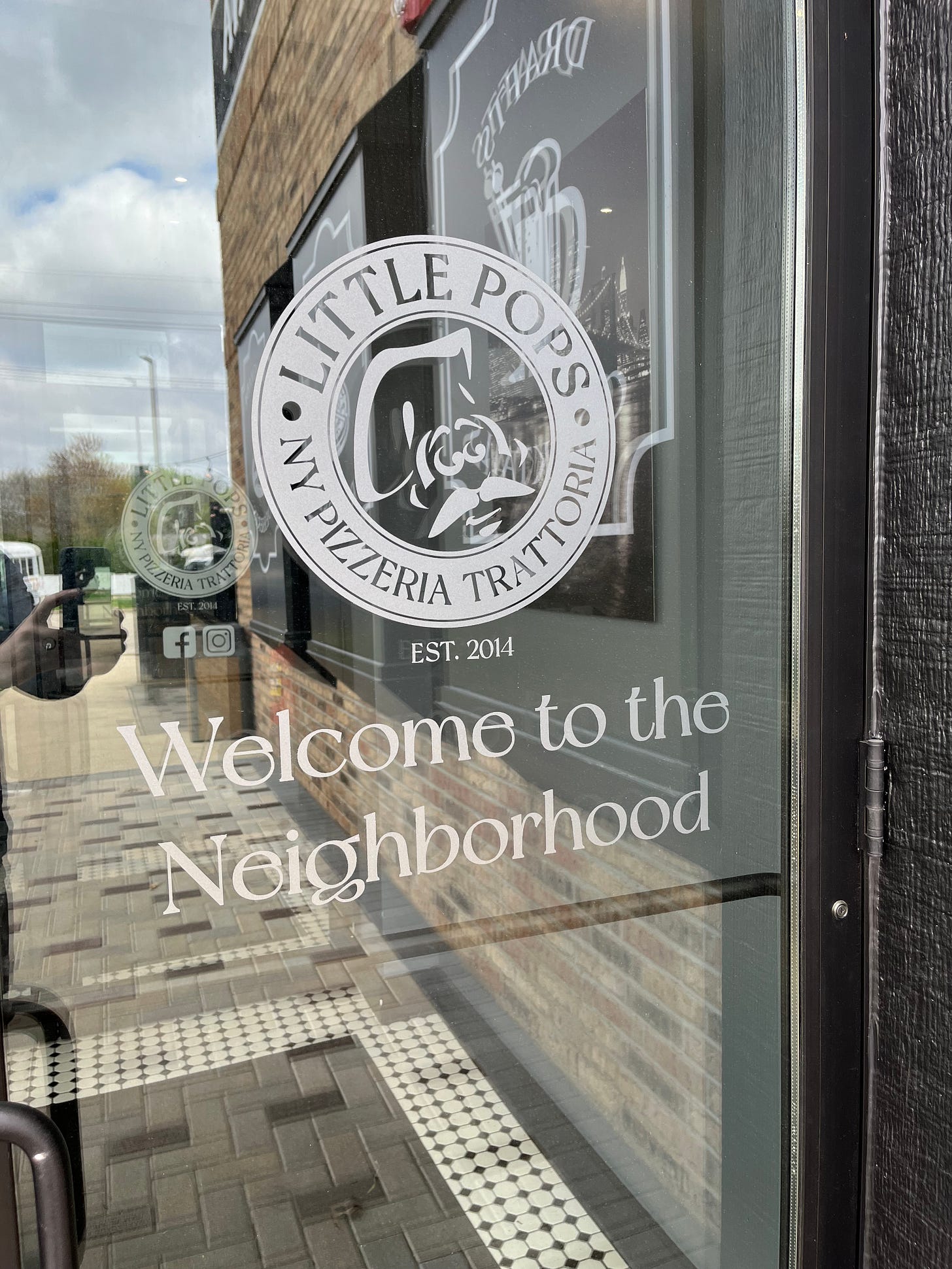
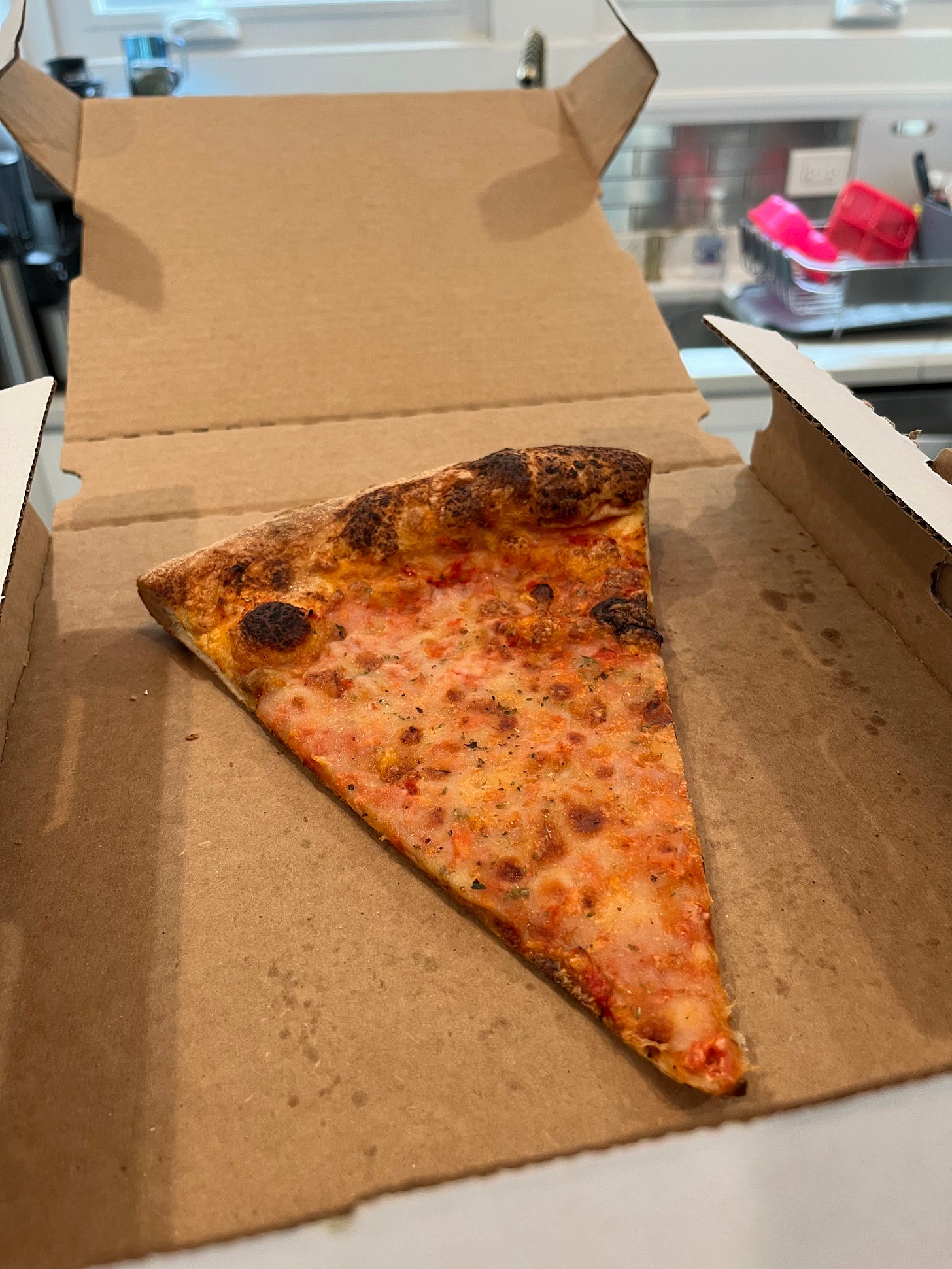
Wow, John’s in Beacon ! An incredible survival story …